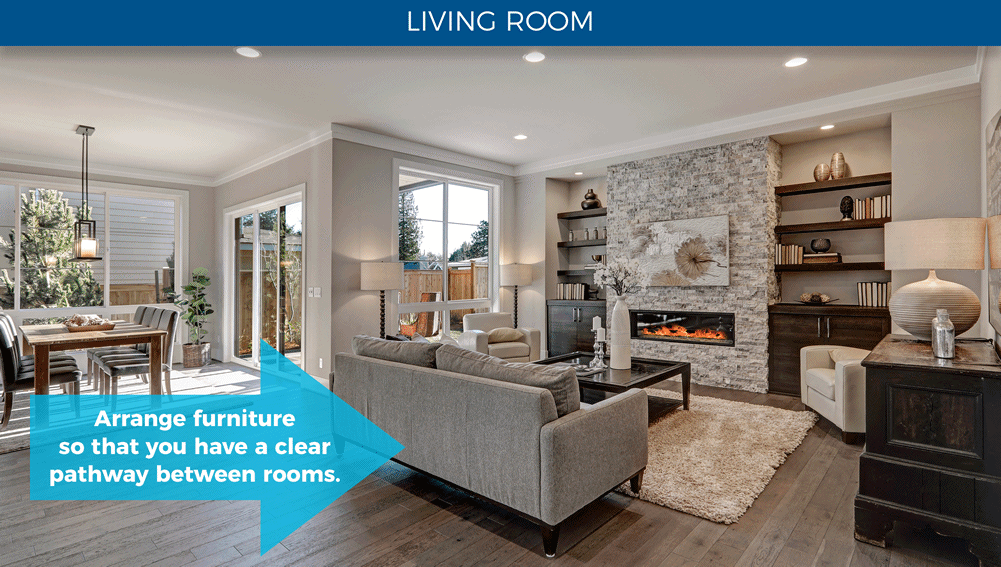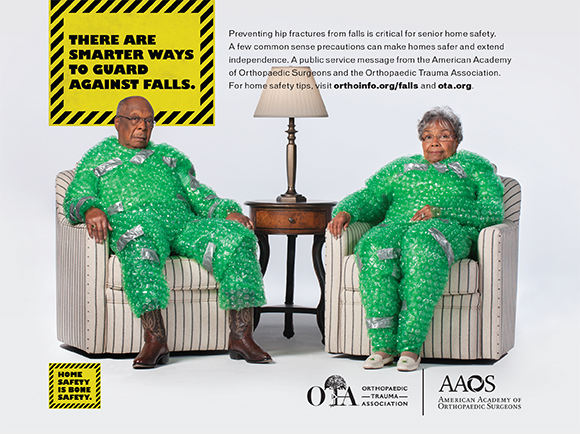Staying Healthy
Preventing Falls Among the Elderly
Falls can happen anytime and anywhere to people of any age. However, as people get older, the likelihood of falls and the severity of injury resulting from falls increases.
According to the Centers for Disease Control and Prevention (CDC), falls are the leading cause of fatal and nonfatal injuries in people age 65 and older. Common injuries include shoulder and forearm fractures, spine fractures, pelvic and hip fractures along with head injuries.
The American Academy of Orthopaedic Surgeons (AAOS) has initiated various efforts to educate the public on the importance of reducing their risks for falls. Most recently, the AAOS launched a national radio public service advertisement (PSA) in partnership with the Orthopaedic Trauma Association (OTA) to further highlight falls prevention awareness, especially in older adults who are at an increased risk of falls. Adults are urged to pay attention to the risk factors surrounding their elderly relatives and encourages them to actively assist in the fall-proofing process.
Simple changes to make around the home
Facts about Falls
- Each year, one in four adults age 65 and older falls, according to the CDC. [1]
- According to the National Hospital Discharge Survey, more than 95% of hip fractures are caused by falling. Three-quarters of all hip fractures occur in women. [2]
- Falls result in more than 2.8 million injuries treated in emergency departments annually, including over 800,000 hospitalizations and more than 27,000 deaths. [3]
- In 2014, the total cost of fall injuries was $31 billion. [4]
- According to the National Council on Aging, the financial toll for older adult falls is expected to increase as the population ages and may reach $67.7 billion by 2020.
Additional Resources for Patients and Caregivers
Know Your Risks
In addition to environmental factors, whether inside or outside the home, many things can put you at higher risk for a fall, such as certain medical conditions or poor dietary habits. It’s important to be aware of these risk factors and make an effort to reduce your risk.
Understand Your Health
- Get an annual eye examination and a physical that includes an evaluation for cardiac and blood pressure problems.
- Maintain a diet with adequate dietary calcium and Vitamin D.
- Do not smoke.
- Avoid excessive alcohol intake.
- Keep an up-to-date list of all medications and frequently provide it to all doctors with whom you consult.
- Check with your doctor(s) about any side effects of your medications and over-the-counter drugs, as fatigue or confusion increases your risk of falling.
- Make sure all medications are clearly labeled and stored in a well-lit area.
- Take medications on schedule with a full glass of water, unless otherwise instructed.
- Talk to your doctor about starting an exercise program.
- If possible, participate in an exercise program that aids agility, strength, balance, and coordination. Climbing stairs, jogging, hiking, dancing, weight training and other activities can help build bone strength and slow progression of osteoporosis, a disorder that causes bones to thin and weaken.
- In addition, active pastimes, such as bicycling and gardening, also can improve health and life quality.
Exercise
- Talk to your doctor about starting an exercise program.
- If possible, participate in an exercise program that aids agility, strength, balance, and coordination. Climbing stairs, jogging, hiking, dancing, weight training and other activities can help build bone strength and slow progression of osteoporosis, a disorder that causes bones to thin and weaken.
- In addition, active pastimes, such as bicycling and gardening, also can improve health and life quality.
Home Modifications to Prevent Falls
- Rearrange furniture. Ensure no furniture is blocking pathways between rooms.
- Reduce clutter. It’s easy to accumulate clutter, such as boxes. Take the time to declutter your home, especially the hallways and stairs.
- Install handrails on both sides of the stairs. Each should be 30 inches above the stairs and extend the full length of the stairs.
- Install nightlights. Keep the halls/walkways in your home well-lit and consider a nightlight in your bathroom. A clear path is especially helpful when trying to get to the restroom in the middle of the night.
- Secure all loose area rugs. Place double-sided carpet tape or slip-resistant backing on all loose rugs around your home, including the bathroom.
- Proper storage. Store items that you use on a regular basis within easy reach. For example, clothes, shoes in your bedroom and dishes and cooking equipment in the kitchen.
- Install grab bars on the shower wall.
- Wear the right footwear. Wear properly-fitting shoes with nonskid soles. Avoid high heels. Tie your shoelaces. Never walk in your stocking feet. Replace slippers that have stretched out of shape and are too loose.
- Clean up immediately any liquids, grease, or food spilled on the floor.
- Designate a play area. Children may have lots of toys scattered around the house. It’s important to contain those toys in a dedicated play area and clean up the toys after kids are done playing to avoid tripping.
- Keep walkways clear. Keep the path between your front door, driveway and mailbox well-lit and clear of debris.
References
- Stevens JA, Ballesteros MF, Mack KA, Rudd RA, DeCaro E, Adler G. Gender differences in seeking care for falls in the aged Medicare Population. Am J Prev Med 2012;43:59–62.
- Parkkari J, Kannus P, Palvanen M, Natri A, Vainio J, Aho H, Vuori I, Järvinen M. Majority of hip fractures occur as a result of a fall and impact on the greater trochanter of the femur: a prospective controlled hip fracture study with 206 consecutive patients. Calcif Tissue Int, 1999;65:183–7.
- Centers for Disease Control and Prevention, National Center for Injury Prevention and Control. Web–based Injury Statistics Query and Reporting System (WISQARS) [online]. Accessed August 5, 2016.
- Burns EB, Stevens JA, Lee RL. The direct costs of fatal and non-fatal falls among older adults—United States. J Safety Res 2016:58.
AAOS does not endorse any treatments, procedures, products, or physicians referenced herein. This information is provided as an educational service and is not intended to serve as medical advice. Anyone seeking specific orthopaedic advice or assistance should consult his or her orthopaedic surgeon, or locate one in your area through the AAOS Find an Orthopaedist program on this website.










